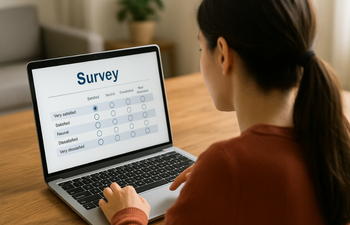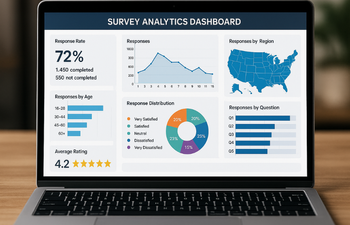Creating Survey Funnels: Turn Questions Into Conversions
Master the art of creating survey funnels to skyrocket conversions by guiding users through personalized experiences.

Introduction
Survey funnels have transformed how digital marketers approach conversion strategies. Instead of bombarding visitors with one-size-fits-all messaging, they provide a smarter, more personalized route, by simply asking questions. But beneath that simplicity lies a strategy-rich mechanism that can unlock powerful consumer insights, drive engagement, and skyrocket your conversion rates.
This guide walks you through every step of creating survey funnels that turn passive viewers into loyal customers. Whether you're nurturing cold traffic or refining your warm leads, the techniques outlined here can help you map out a successful, scalable survey funnel framework.
What Is a Survey Funnel?
At its core, a survey funnel is an interactive lead generation tool. Rather than dumping all content or offers onto a landing page, it guides users through a sequence of targeted questions. These questions are designed to:
- Segment the audience based on their responses
- Build trust through personalization
- Match users with the most relevant offers or content
Instead of guessing what your users need, survey funnels allow them to tell you directly, no crystal ball needed.
Why Survey Funnels Work So Well
Survey funnels tap into fundamental psychological triggers:
- Curiosity: Users want to see the results.
- Commitment: Starting with small questions increases the likelihood of completing the funnel.
- Personalization: Tailored outcomes feel more valuable.
By leveraging these triggers, you can create a seamless, persuasive journey that feels more like a helpful conversation than a pitch.
Components of a High-Converting Survey Funnel
Every effective survey funnel shares a few core components:
- A compelling hook or entry question
- Progress indicators to reduce friction
- Clear segmentation logic
- Dynamic outcomes based on user answers
- A strong, relevant CTA (Call To Action)
Without one of these components, the user experience can fall flat, decreasing the chance of conversion.
Crafting Your Hook: Asking the First Question
The first question should be low-friction and relevant. Think of it as the “icebreaker” in your funnel conversation. Avoid open-ended questions at this stage, go for quick taps or multiple choice.
Examples:
“What’s your biggest fitness goal?”
“Which of these best describes your business?”
This sets the tone and guides the segmentation logic for the rest of the journey.
Choosing the Right Survey Funnel Platform
Different tools suit different needs. Here’s a quick comparison of popular options:
Choose the tool that aligns with your team’s workflow, budget, and complexity needs.
Mapping Your Funnel Logic
Before building your survey, map the logic. Each answer should lead logically to the next question or segment. Use flowcharts to visualize user paths.
Tips:
- Avoid dead ends, every answer should have a next step.
- Test the paths for coherence and clarity.
Segmenting Your Audience with Precision
Segmentation is the heartbeat of a good funnel. Use answers to filter users into groups such as:
- Pain point categories
- Budget tiers
- Readiness to buy
- Industry verticals
Then match each segment to a unique offer or message.
Personalizing Outcomes for Better Results
Once segmented, deliver a personalized experience. This could be:
- A tailored product recommendation
- A customized video message
- A downloadable resource based on answers
This extra effort dramatically increases perceived value.
Writing Copy That Converts in a Survey Funnel
Even the best logic fails without good copy. Keep it conversational, concise, and user-focused. Here’s how:
- Use second-person language (“you,” “your”)
- Highlight benefits, not just features
- Insert emotional hooks and urgency
Avoid jargon or complexity. Clarity beats cleverness in survey copy.
Visual Design and User Experience
Design impacts trust and usability. Make sure your survey funnel:
- Uses your brand colors and fonts
- Is mobile-responsive
- Includes plenty of white space
- Has intuitive navigation
Visuals should support, not distract from, the journey.
A/B Testing Your Survey Funnel
Don’t guess. Test. Try variations of:
- Opening questions
- CTA phrasing
- Number of questions
- Images or videos used
Track metrics like completion rate, bounce rate, and conversion rate to decide winners.
Integrating with CRM and Email Tools
Once you collect data, put it to work. Integrate your survey tool with:
- Mailchimp, ConvertKit, ActiveCampaign for follow-ups
- Salesforce or HubSpot for sales alignment
- Zapier for custom workflows
This ensures smooth transitions between your funnel and your sales or marketing team.
Using Conditional Logic to Guide Users
Conditional logic means different questions or outcomes appear based on previous answers. This is what gives survey funnels their power.
Example:
This improves user experience by keeping questions relevant.
Optimizing for Mobile Survey Funnel Users
More than half of all web traffic is mobile. Design with thumbs in mind:
- Use large buttons
- Avoid dropdown menus
- Keep text minimal
- Load fast
Poor mobile experience = funnel abandonment.
Embedding Survey Funnels on Your Website
Use pop-ups, exit-intent modals, or embed the survey on your homepage or blog.
Popular places to embed:
- After blog posts
- Inside product pages
- On your homepage hero section
Strategic placement can double participation rates.
Driving Traffic to Your Survey Funnel
A great funnel is useless without traffic. Drive visits using:
- Paid social media ads (Facebook, Instagram)
- Google PPC campaigns
- Email marketing
- Influencer partnerships
- Organic blog traffic
Monitor your traffic sources to optimize ad spend and targeting.
Retargeting Drop-Offs
If someone starts but doesn’t complete the funnel, retarget them with tailored ads or email nudges.
Example:
“Still curious about the best skincare for you? Take our 30-second quiz!”
This gentle reminder can recover lost leads.
Tracking and Analyzing Survey Funnel Performance
Use metrics to refine performance:
Check these weekly to make iterative improvements.
Real-Life Examples of Successful Survey Funnels
- Warby Parker: Uses a quiz to match users to glasses.
- HelloFresh: Surveys dietary needs for meal plans.
- Dollar Shave Club: Personalizes grooming kits based on answers.
For more on how to craft effective survey questions, see our post on How to Write Survey Questions People Actually Want to Answer.
Avoiding Common Survey Funnel Mistakes
Mistakes to watch for:
- Too many questions
- Irrelevant or generic outcomes
- No personalization
- Poor mobile UX
- Weak follow-up strategy
If you're interested in reducing survey fatigue, check out our article on Survey Fatigue Is Real.
Awareness of these will help you build better, faster.
Future of Survey Funnels in Marketing
With AI, survey funnels will become even more dynamic, adjusting in real time based on user behavior. Voice-activated surveys and chatbot integrations are already emerging.
Staying ahead of this curve means continual testing and iteration.
Final Thoughts on Creating Survey Funnels
Creating a survey funnel isn’t just a trend, it’s a strategic shift in how marketers approach conversations with their audience. By prioritizing engagement and personalization, you foster stronger relationships and more qualified leads. With the right tools and tactics, turning questions into conversions becomes not only possible, but predictable.
Frequently Asked Questions
Find answers to the most common questions about this topic
A survey funnel is a marketing technique that uses a series of guided questions to segment audiences and deliver personalized offers, increasing conversions.
They engage users, gather data, and deliver customized solutions, making the customer feel heard and understood, which boosts conversion rates.
Popular tools include Typeform, SurveySparrow, Jotform, and ClickFunnels, all of which offer customizable templates and analytics.
Absolutely! Survey funnels are effective in both B2B and B2C for lead qualification, segmentation, and tailored messaging.
Overloading with too many questions, unclear CTAs, lack of personalization, and poor follow-up strategy are key pitfalls to avoid.
Ideally, a survey funnel should include 3 to 7 questions, just enough to engage and segment users without causing drop-offs.









